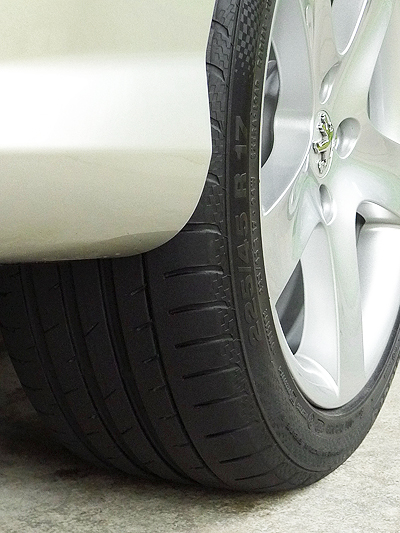It is neither tyre width nor aspect ratio [profile] influences the size of the tyre's contact area with the road surface. The size of the contact patch is actually determined by the weight on the wheel and the tyre pressure. Wider tyres will shorten contact length hence contributes aquaplaning.

MYTH: A larger contact patch gives more grip
Larger contact patch is irrelevant to better grip. If u understand applied physics [remember Amonton's Law, F=uN ? where F is the force generated, u is the coefficient of friction, and N is the weight on the surface considered, i.e the weight on the tyre]
The actual grip that a tyre can achieve is influenced by the coefficient of friction of the rubber compound used in the tyre. The higher the coefficient, the more grip which can be generated.
So its not the tyre width but the compound used that determines the grip [put aside about suspension first - we are only discussing tyres here].
So, why not use narrow high profile tyres then?
 The answer to that is heat (we are talking on grip here, not handling). The point is that, to get a contact patch of a certain size on the road, it needs a certain portion of the tyre to be flat. Now, for a narrow tyre, the contact patch will be quite long compared with a wide tyre. This introduces two problems for the tyre.
The answer to that is heat (we are talking on grip here, not handling). The point is that, to get a contact patch of a certain size on the road, it needs a certain portion of the tyre to be flat. Now, for a narrow tyre, the contact patch will be quite long compared with a wide tyre. This introduces two problems for the tyre.First, to get that long flat section to give the required contact patch area, the sidewall of the tyre needs to deform quite a lot. This deformation actually causes continuously bending and unbending the rubber of the sidewall as it flattens and then the tread curves again resulting in a lot of heat being generated.
The second relates to the length itself. There will be a greater percentage of the tyre tread in contact with the road than if the contact patch length were shorter; this reduces the amount that the tread can cool. Also, there is a greater percentage of sidewall at any given time that is actually under bending stresses, again resulting in less opportunity to cool. As a result on this increased generation of heat, and the reduced capacity for self cooling, the tyres need to be made of a harder rubber compound that is more able to resist heat. This harder compound will however, have a reduced coefficient of friction hence loosen grip.
FACT: The tyres that are wider can have a softer compound with better frictional properties. Due to the reduced bending stresses, and greater cooling opportunities, the tyre will tend to stay within a narrow temperature range quite consistently, giving greater grip, while reducing the tendency for overheating - hence better performance.
As far as tyre profile is concerned, the main benefit is one of handling - the lower sidewalls give reduced sidewall deformation under lateral loading, which results in improved steering response and a more stable contact patch.
FACT: On the issue of wheel size [the diameter, not the width], it is therefore clear that increasing the wheel/tyre diameter combination is beneficial. The reason for this is that the tyre will not have to deform so much to get the required contact patch length, and the percentage of the tyre tread in contact with the road will be less than for a smaller diameter combination.
What about tyre pressure?
Obviously, tyre pressure plays a very important part, but there are limits also. Too high tyre pressure can damage the carcass. Too low presure will generate massive heat, and have the tyre slipping on the rim.
One issue to consider is that, for wet weather driving [for cars equiped with ABS and ESP - like 308T], in contrary to normal practice, it is better to increase tyre pressure, not reduce it. The reason is that there is a relationship between tyre pressure and the speed at which there is the onset of aquaplaning. The lower the pressure on the road (pressure being a factor of weight and contact area), for a given tyre design, the more likely the car is to aquaplane.
What factors are important in terms of tyre grip?
Tyre width has no direct relation to the amount of grip generated; it is a secondary factor, and the width basically relates to cooling potential and so the tyre compound that can be used. The size of the contact patch has no bearing on the amount of grip generated at all, apart from the extreme of where the compound is getting so hot that it no longer acts as a solid.
The tyre pressure has a bearing on the heating and cooling characteristics of the tyre. Having a lower tyre profile gives improved handling through reduced sidewall stress and improved contact patch shape stability but less resistance to aquaplane.
| HOME | Tyres| Fuel Consumption | Performance |
| uncle's DIY |Car Size Comparison | Motoring Myths | RON95 |
3 comments:
smaller tyre... usually cheaper
low profile, bigger tyre.. usually more or damn more expensive.
generally this statement is always true... hehehehe
btui tak uncle :)
good info...
great info again as always, UncD
Post a Comment